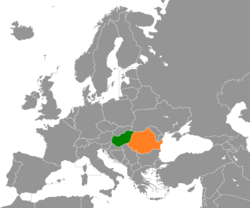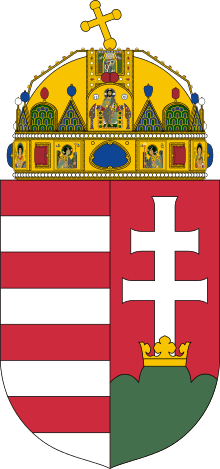Hungary–Romania relations
 | |
Hungary |
Romania |
|---|---|
Hungarian-Romanian relations are foreign relations between Hungary and Romania. Relations between the two nations date back from the Middle Ages, including Wallachia and Moldavia. Modern diplomatic relations between the two states are dating since the creation of Romania.
Their relationship is considered as "cold behind the warm" due to historical issues between two countries.
Country comparison
| 2018 | ||
|---|---|---|
| Population | 9,830,485 | 19,760,000 |
| Area | 93,028 km2 (35,919 sq mi) | 238,391 km2 (92,043 sq mi) |
| Population Density | 105.9/km2 (274.3/sq mi) | 84.4/km2 (218.6/sq mi) |
| Capital | Budapest – 1,759,407 (2,524,697 Metro) | Bucharest – 1,883,425 (2,272,163 Metro) |
| Largest City | ||
| Government | Unitary parliamentary constitutional republic | Unitary semi-presidential constitutional republic |
| Official language | Hungarian | Romanian |
| Main religions | 38.9% Catholicism (Roman; Greek), 13.8% Protestantism (Reformed; Evangelical), 0.2% Orthodox, 0.1% Jewish, 1.7% other, 16.7% Non-religious, 1.5% Atheism, 27.2% undeclared | 81% Orthodox, 6.2% Protestantism, 5.1% Catholicism, 1.5% other, 0.2% Non-religious, 6% missing data |
| Ethnic groups | 83.7% Hungarian, 3.1% Roma, 1.3% German, 14.7% not declared | 88.9% Romanians, 6.5% Hungarian, 3.3% Roma, 0.2% Ukrainian, 0.2% German |
| Currency | Hungarian forint (Ft) – HUF | Romanian leu – RON |
| GDP (PPP) | $265.037 billion, $26,941 per capita | $517.505 billion, $26,499 per capita |
| GDP (nominal) | $132.683 billion, $13,487 per capita | $245.590 billion, $12,575 per capita |
| Ethnic populations | 35,641 ethnic Romanians lived in Hungary in 2011 (census)[1] | 1,227,623 ethnic Hungarians lived in Romania in 2011 (census) |
Bilateral relations
Hungary has an embassy in Bucharest, two general consulates (in Cluj-Napoca and Miercurea Ciuc) and four honorary consulates (in Constanța, Iași, Drobeta-Turnu Severin and Timișoara).[2] Romania has an embassy in Budapest and two general consulates (in Gyula and Szeged). The two countries share 443 km of common border. Both are full members of NATO and of the European Union.
Romania has developed strong relations with Hungary, with the latter playing a key role in supporting Romania's bid to join the EU. Romania's ethnic Hungarian party also participated in all the government coalitions between 1996 and 2008 and from 2009. In 1996, Romania signed and ratified a basic bilateral treaty with Hungary that settled outstanding disagreements, laying the foundation for closer, more cooperative relations.[3]
Business
In 2012, the total amount of international trade between Romania and Hungary was 7.3 billion euro, of which exports from Romania were 2.4 billion euro, whereas exports from Hungary were 4.9 billion euro.[4] Hungary ranks as the third of Romania's trade partners, after Germany and Italy.[5]
MOL Group and OTP Bank, two of Hungary's largest companies,[6] are present in Romania since 2003 and 2004 respectively.[7][8] MOL Group operates (as of August 2013) a network of 138 fuel stations in Romania, which accounts for approximately 10 percent of the total network. OTP Bank has a widespread network of branches in Romania, with presence in every county.[9]
Wizz Air is a low-cost airline from Hungary, which operates flights from several airports in Romania (Bucharest, Cluj-Napoca, Târgu Mureș, Sibiu, Timișoara, Iasi, Suceava and Craiova) to various destinations in Europe.[10] It is the largest low-cost airline operating in Romania,[11] and in 2013 it carried 3.2 million passengers on its over 72 local routes.[12]
RCS & RDS, Romania's leading company in internet and cable and satellite television services, is arguably the second or third company on the television market in Hungary, with (as of August 2013) around 22.4 percent of market share.[13]
Hungary → Romania
| Million (€) | 2012 | 2013 | 2014 | 2015 | .. | 2017 |
|---|---|---|---|---|---|---|
| Export | 4,767.23 | 4,600.36 |
4,609.39 |
4,742.39 |
.. | 5,600.00 |
| Import | 2,050.98 | 2,120 |
2,500.07 |
2,550.72 |
.. | 2,900.00 |
| Balance | 2,716.25 | 2,480.34 | 2,109.32 | 2,191.68 | .. | 2,700.68 |
Most important Hungarian investors in Romania: MOL, OTP Bank, Gedeon Richter Plc.
Most important Romanian investors in Hungary: RCS & RDS.
Sports
In ice hockey, teams from the two countries, as well as from Slovakia, compete in the MOL Liga. The competition was established in 2008 and comprises four teams from Hungary, two from Romania and one from Slovakia.[16]
In women's handball, CSM București and Gyori ETO met in the 2016 Champions League Final, making it the first time two teams from this countries meet in an EHF Champions League final. CSM won their first title after they beat Gyor 29–26, with 25–25 after extra-time and 4–1 at penalties.
Conflict
Despite having a relationship, many Hungarians believe that Romania did not deserve the current territory, because Transylvania was the integral part of the Kingdom of Hungary (1000-1526, 1848-1849, 1867-1920) and the Lands of the Hungarian Crown (Eastern Hungarian Kingdom (1526-1570), Principality of Transylvania (1570-1867)) until the Treaty of Trianon.
World War I
During the war, initially the Kingdom of Romania was neutral to the Central Powers, thus with Austria-Hungary. In August 1916 the Romania entered the war on side of the Allies and attacked the Kingdom of Hungary, however it was pushed back to the frontier in October and by January 1917, two-thirds of Romania were occupied by the Central Powers. The Romanians were forced to retreat to the historical region of Moldavia, but were able to stave off complete collapse in 1917 by reorganizing their army and repulsing the Central Powers' offensive at Mărășești and Oituz. Nevertheless, after the October Revolution of 1917, Russia fell into civil war, and the Russian government signed two ceasefire agreements with the Central Powers, followed later (on December 15) by a full armistice. Lacking Russian support, the Romanian government was subsequently forced to sue for peace, concluding in December 1917 the Armistice of Focșani.
Hungarian–Romanian War
In 1918, Romania re-entered the war with similar objectives to those of 1916. During the 1919 Hungarian–Romanian War Hungary, led by Communist forces, tried to secure its borders, however it was soon defeated and later occupied by Romanian forces for a few months' time.
Treaty of Trianon
The Treaty of Trianon was the peace agreement of 1920 that formally ended World War I between most of the Allies (among them the Kingdom of Romania) and the Kingdom of Hungary, the latter being one of the successor states to Austria-Hungary. As a result of the treaty the regions of Transylvania, parts of the Banat, Crișana and Maramureș became part of the Kindom of Romania.
Interwar period and World War II
The Treaty of Trianon and its consequences dominated Hungarian public life and political culture in the inter-war period. Moreover, the Hungarian government swung then more and more to the right; eventually, under Regent Miklós Horthy, Hungary established close relations with Benito Mussolini's Fascist Italy and Adolf Hitler's Nazi Germany. These politics and the sought for revision succeeded to regain the territories of southern Czechoslovakia by the First Vienna Award in 1938 and the annexation of the remainder of Subcarpathia in 1939. These were only a fraction of the territories lost by the Treaty of Trianon, anyway the loss that the Hungarians resented the most was that of Transylvania ceded to the Romanians.
In 1940, the Soviet occupation of Bessarabia and Northern Bukovina inspired Hungary to escalate its efforts to resolve "the question of Transylvania". Hungary hoped to gain as much of Transylvania as possible, but the Romanians submitted only a small region for consideration. Eventually, the Hungarian-Romanian negotiations fell through entirely. After this, the Romanian government asked Italy and Germany to arbitrate. Foreign Ministers Joachim von Ribbentrop of Germany and Galeazzo Ciano of Italy met on 30 August 1940 at the Belvedere Palace in Vienna and decided that Romania cede Northern Transylvania, with an area of 43,104 km2 (16,643 sq mi) and a population of 2,577,260, out of which, according to the Romanian estimates, 1,304,903 were Romanians (50.2%) and 978,074 (37.1%) Hungarians,[17] or, according to the Hungarian census of 1941, 53.5% were Hungarians and 39.1% Romanians.[18]
In 1940 ethnic disturbances between Hungarians and Romanians continued after some incidents following the occupation of Northern Transylvania by the Hungarian military, culminating in massacres at Treznea and Ip. After some ethnic Hungarian groups considered unreliable or insecure were sacked/expelled from Southern Transylvania, the Hungarian officials also regularly expelled some Romanian groups from Northern Transylvania. Also, many Hungarians and Romanians fled or chose to opt between the two countries. There was a mass exodus; over 100,000 people on both sides of the ethnic and political borders relocated.[19]
During World War II, Hungary and Romania became allies and participated in the war against the Soviet Union. But after the coup on 23 August 1944 Romania switched sides and fought against Hungary. Consequently, Soviet and Romanian troops invaded Hungary, occupied Northern Transylvania by October 1944 and re-established the Romanian administration in the region in March 1945. The 1947 Treaty of Paris reaffirmed the borders between Romania and Hungary as originally defined in Treaty of Trianon 27 years earlier, thus confirming the return of Northern Transylvania to Romania.
Football history
In 1982 World Cup qualifying, Romania lost 0–1 in Budapest and failed to gain a win by just a goalless draw. From then, Romania and Hungary, once again, faced the same group in the 2002 WC qualifying, this time Romania won both home and away 2–0. However, conflicts between Romanian and Hungarian fans only grew when Romania faced Hungary in 2014 World Cup qualifying, in which Romania eventually drew 2–2 in Budapest before defeating Hungary 3-0 at home. In the match held at Ferenc Puskás Stadium, FIFA had banned fans from visiting the stadium because of the former happenings in the Hungary-Israel friendly match.
In UEFA Euro 2016 qualifying, both teams were once more drawn to the same group. On 11 October 2014 Hungary and Romania drew 1–1 during a playoff in Bucharest. In the second round, both teams drew 0–0 at Groupama Arena on 4 September 2015.
See also
References
- ↑ "Hungarian census 2011 - final data and methodology" (PDF). ksh.hu. Retrieved 2015-05-18.
- ↑ http://www.mae.ro/bilateral-relations/1748
- ↑ http://www.dri.gov.ro/lege-nr-1131996-pentru-ratificarea-tratatului-de-intelegere-cooperare-si-buna-vecinatate-dintre-romania-si-republica-ungara-semnat-la-timisoara-la-16-septembrie-1996/
- ↑ http://www.business24.ro/macroeconomie/exporturi/exporturile-romaniei-catre-ungaria-s-au-dublat-in-ultimii-patru-ani-dar-raman-la-jumatatea-importurilor-1532009
- ↑ http://www.dce.gov.ro/Comunicate/com_2013/26_nov_ung.htm
- ↑ http://www.zf.ro/business-international/top-500-companii-europene-in-functie-de-capitalizarea-bursiera-opt-sunt-poloneze-trei-din-cehia-si-doua-din-ungaria-niciuna-din-romania-11146281/
- ↑ http://www.zf.ro/companii/mol-a-alocat-12-mil-euro-pentru-integrarea-statiilor-shell-2891691/
- ↑ http://www.otpbank.ro/ro/despre-noi/otp-bank-romania/istoric/
- ↑ http://www.otpbank.ro/ro/despre-noi/retea-interna/lista-sucursale/sucursale/index.html
- ↑ https://wizzair.com/ro-RO/Country/RO
- ↑ http://www.wall-street.ro/tag/wizz-air.html
- ↑ http://www.zf.ro/companii/wizz-air-a-transportat-anul-trecut-3-2-mil-pasageri-din-si-spre-romania-in-crestere-cu-14-11862392
- ↑ http://www.wall-street.ro/articol/IT-C-Tehnologie/152401/cum-arata-piata-de-tv-din-ungaria-o-tara-in-care-noul-sef-al-liderului-in-domeniu-este-romanca-severina-pascu.html
- ↑ MKIK Gazdaság- és Vállalkozáskutató Intézet
- ↑ https://ziarulunirea.ro/tarile-din-ue-in-care-romania-a-importat-si-exportat-cele-mai-mari-cantitati-de-marfuri-469442/
- ↑ http://eurohockey.com/league/409-mol-liga.html
- ↑ Charles Upson Clark (1941). Racial Aspects of Romania's Case. Caxton Press.
- ↑ Károly Kocsis, Eszter Kocsisné Hodosi, Ethnic Geography of the Hungarian Minorities in the Carpathian Basin, Simon Publications LLC, 1998, p. 116
- ↑ A történelem tanúi - Erdély - bevonulás 1940 p 56. - The witnesses of history - Transylvania - Entry 1940 p. 56. - ISBN 978-963-251-473-4

